
The best exercises for hip osteoarthritis will depend on your age, current health and mobility levels, the stage of your arthritis and most importantly, what exercise you like to do. If you hate a particular form of exercise, you are unlikely to stick to it, so often the best form of exercise is the one you will do! However, if exercise is aggravating your hip arthritis pain, there are many things that can be done to exercise more comfortably. Read on to find out some great tips on the best exercises for hip osteoarthritis.
In this blog, we’ll start off with some great tips on exercising safely with hip osteoarthritis including:
Then we’ll take you through the different types of exercises you need to do for hip osteoarthritis:
For each key exercise, we’ve also provided some advice from expert physical therapist, Dr Alison Grimaldi. We’ll tell you exactly how to modify specific exercises to allow you to exercise safely with hip osteoarthritis: read more in each section of this blog.
At the end of this blog, you’ll also find some bonus information:
Have you stopped exercising because every time you try, you just irritate your hip pain? This is common, with most people unsure what exercise is safe to do with hip arthritis. Stopping exercise may lead to weight gain, which is not ideal for the joints of your legs. A lack of exercise also has other negative impacts on physical and mental health.
Let’s first talk about some general rules for exercising with hip osteoarthritis.
Often when given a diagnosis of hip arthritis, many will jump straight into exercise and go-hard, trying to lose weight, get fit or get strong as quickly as possible. The joint can’t cope with the sudden increase in activity and the pain flares, requiring a period of rest, before trying again and getting the same result – we refer to this as the BOOM-BUST pattern of exercise. Each time you flare your joint, you increase the inflammation in the joint, providing an unhealth environment for your cartilage.
Continually inflaming your joint through poor exercise habits (BOOM-BUST) may lead to more rapid deterioration in your hip cartilage. That’s why it’s so important to find the right exercise and the right exercise intensity for you and your hip.
When you first start to exercise or return to exercise after a pain flare or illness, start slowly – do less than you think you can manage initially and see how your body responds over the next 24-48 hours. Remember, even though your hip might seem to be coping during that first exercise session, the inflammatory response to doing too much might peak 24-48 hours later. A common response is to have a really bad night’s sleep and to wake up stiff the next morning after doing too much. Then you’ll need to rest until it settles (Boom-Bust). By starting slowly, you will avoid the constant aggravation of hip pain and inflammation. Any flare ups then will be mild and not last as long, allowing you to adapt your exercise depending on your response, and keep exercising. Only increase your exercise volume (how much you are doing) by 10% per week as a general rule.1
This is one of the most common questions we get asked as health professionals. It’s important to remember that pain is not directly correlated with damage – so some mild discomfort is usually totally fine to exercise through – once you have established that initial baseline i.e., that your hip is coping over the first week or so of exercise. However, pushing through moderate or severe levels of pain may result in a flare of pain and inflammation and can put you back on that Boom-Bust cycle.
So, how much pain is ok? If we use the 0-10 pain scale where 0 = No pain and 10 = Worst imaginable pain, a good basic guide is to use the Traffic Light Approach:
We have written another whole blog on this topic: Click here to read more
If you have constantly high levels of pain, even without exercising, seek advice from a health professional before you start. Pain is a complex thing and as we mentioned above, pain levels do not directly match levels of physical damage in your joint or other tissues. Pain is a protective system, and sometimes it becomes a little too protective. You can read further about pain on a page we have written on this topic.
Click here to read more about understanding pain.
If your doctor or other registered health professional had given you clearance to start exercising, they will have likely given you guidelines. Otherwise, as a general rule, aim to avoid increasing your starting level of pain by more than 2 points on the 0-10 scale when exercising. And stick with the start slowly, listen to your response and progress slowly rules.
Let’s move on to discussing specific forms of exercise, starting with cardio or aerobic exercise. It’s important to try to do some cardio for your physical and mental health and sleep quality, but what is the best cardio exercise for hip osteoarthritis?
Putting weight through a painful joint with arthritis might not seem like a good thing to do, but it really depends on the stage of osteoarthritis and how your joint copes with it. If you use the traffic light approach above and you are in the green zone when exercising, and do not have increased night pain or morning stiffness the next day, your joint would appear to be coping. Many people the joint can cope with walking and even running in early to moderate stages of arthritis and some manage to continue to at least walk for exercise into the advanced stages of the condition. Others will need to swap to a lower impact form of cardio. Listen to your body and if you’re not sure, seek help from a health professional – click here to find a hip pain professional near you.
Before giving up on walking or running as a form of exercise, try these simple strategies to modify your activity and help move you from an Amber Zone on the Traffic Light to the Green Zone.

Would you like to purchase your own Walking Poles?
Want to explore the range of walking poles we recommend?
Click the link below to find out more!
Yes, it is. As we always say, Motion is Lotion! This type of cyclical action is great for flowing the synovial fluid (normal joint fluid) around the joint, which is important for delivery of nutrients to the cartilage. Cycling is a low impact exercise compared with walking or running, so this can be a great way to keep fit and strong when walking and running have become more limited. You might prefer cycling outdoors, or indoors on a wind-trainer or a stationary exercise bike at the gym or at home.
Even though cycling is low-impact exercise, riding a bike can still aggravate hip pain related to hip osteoarthritis. This is usually related to higher forces at the front of the hip when in a position of high hip flexion – knees closer to the chest, or to high muscle forces across the joint when working hard e.g., cycling uphill, or pulling up hard in cleats.
Here are some strategies to reduce hip pain when cycling:
The water can be a great place for cardiovascular or aerobic fitness exercise when you have hip arthritis. The is because of the reduced impact forces being put through the joints in water compared with on dry land. There are many different options for water-based exercise and things to consider when you have hip osteoarthritis.
Options for water-based cardio exercise:
There are a number of other low-impact cardio exercise options for hip osteoarthritis in the gym – the cross-trainer or elliptical trainer, the stepper, the rowing machine or an arm ergo.
Cross-trainer or elliptical machines can be a great exercise option if you have hip osteoarthritis, as there are no impact forces. However, the how you move on the machine and how much you do, will influence how your hip copes.
Here are some top tips for using a cross trainer or elliptical machine with hip osteoarthritis:
Start slowly and gradually build – as we have mentioned above, start with a little – even just a few minutes – and see how your hip responds. Gradually build up exercise time if your hip is coping.
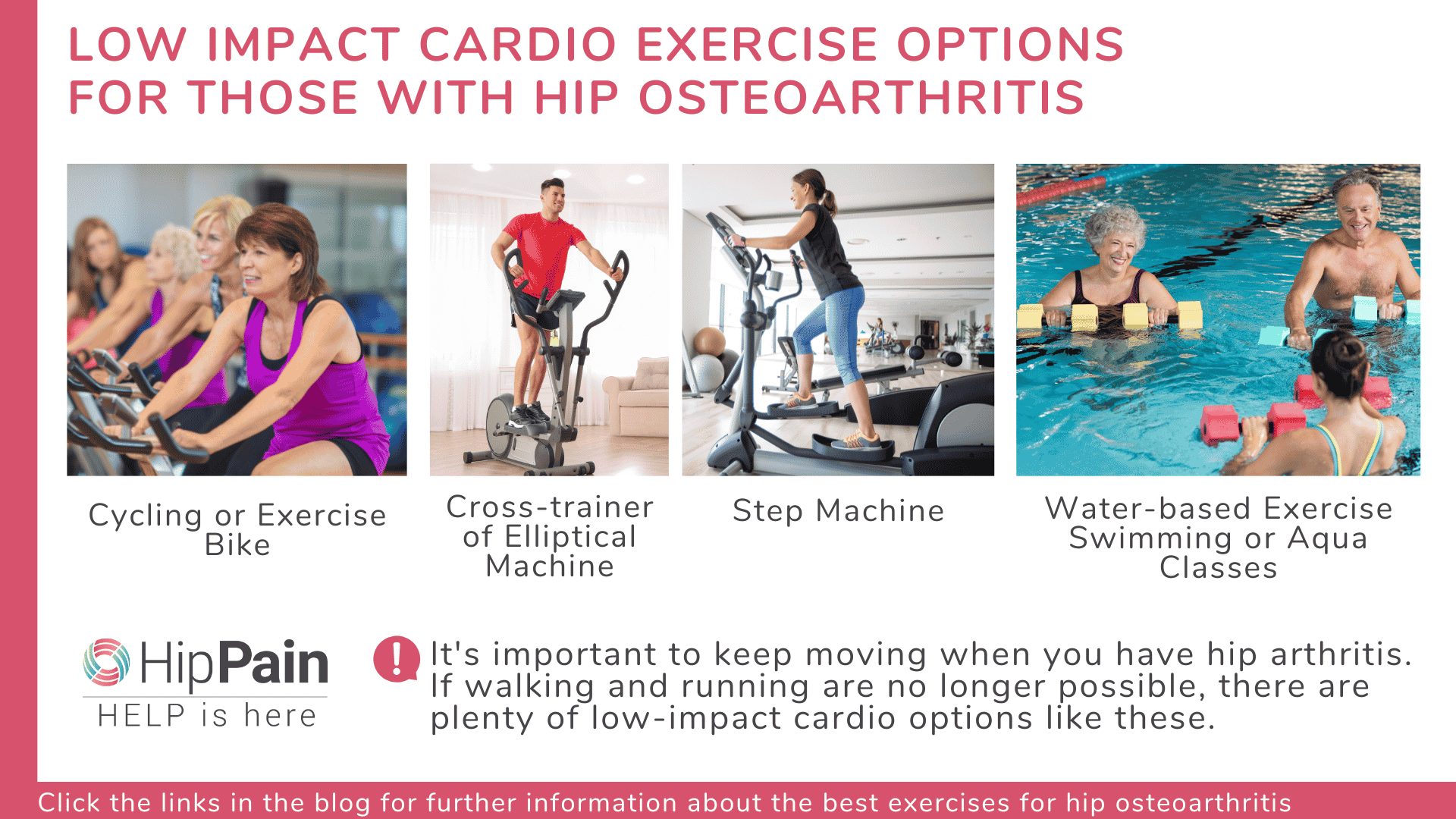
A stepper or step machine can also be a good choice in the gym for exercising with hip osteoarthritis, as it is a low-impact exercise. However, it can be quite a challenging cardiovascular exercise and can aggravate hip pain depending on how and how much you step.
Here are some top tips for using a stepper or step machine with hip osteoarthritis:
Don’t swing your hips side to side – As with the ellipticals, try to keep your pelvis fairly still – hips stay still, legs move underneath.
As health professionals, we often get asked about the rowing machine by people with hip osteoarthritis. The answer is – it depends … Some people with hip arthritis can manage rowing very comfortably, but this doesn’t suit others. The main issue is the amount of bend at the hips when your body leans forward for the catch. If your hip is easily aggravated by flexion – bringing your knees close to your chest – then your hip may not cope with rowing. However, the bending forward action of rowing is shared with the back, so people who curl from their back may alleviate the pressure on their hips. If your hips are stiff, this will increase the load on your back, so even if your hips cope, you need to be mindful of not overload your back.
Some advice for using a rower or rowing machine with hip osteoarthritis:
Wherever possible, choose a strengthening exercise for the gluteals (buttock muscles) where your foot is attached to the ground. This weightbearing stimulus is particularly important for the gluteal muscles, whose main focus is to push through your foot to hold your body up and move your body against the downward force of gravity. If your gluteals are weak and/or a bit sleepy, weightbearing or ‘closed-chain’ exercise with your foot on the ground is particularly useful for stimulating these muscles.3
Here are a few great ones to start with and how to do them in comfort at the hips, knees and back.
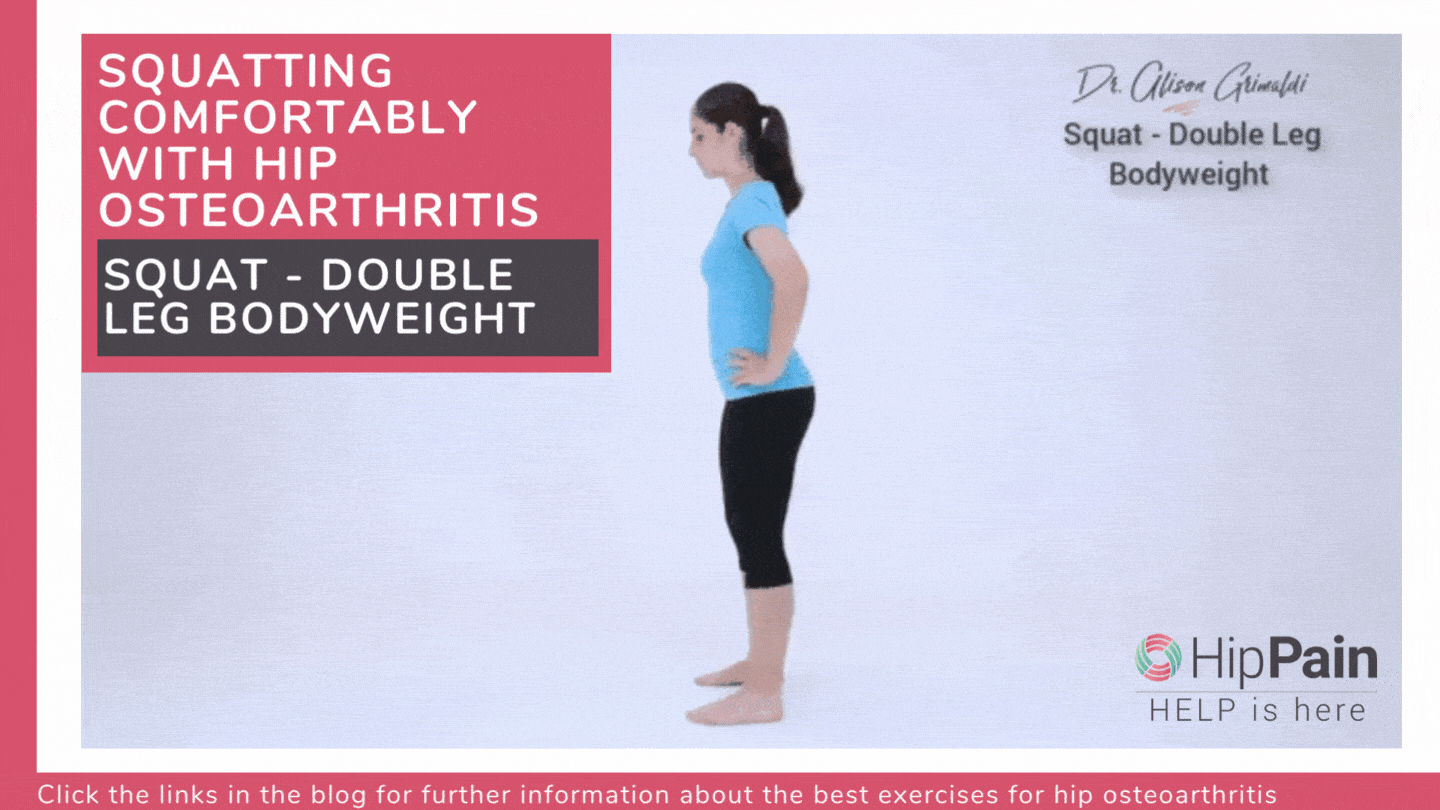
Many people find their hips are aggravated with squatting, but others can’t squat because of knee or back pain. Here are some tips for squatting comfortably.
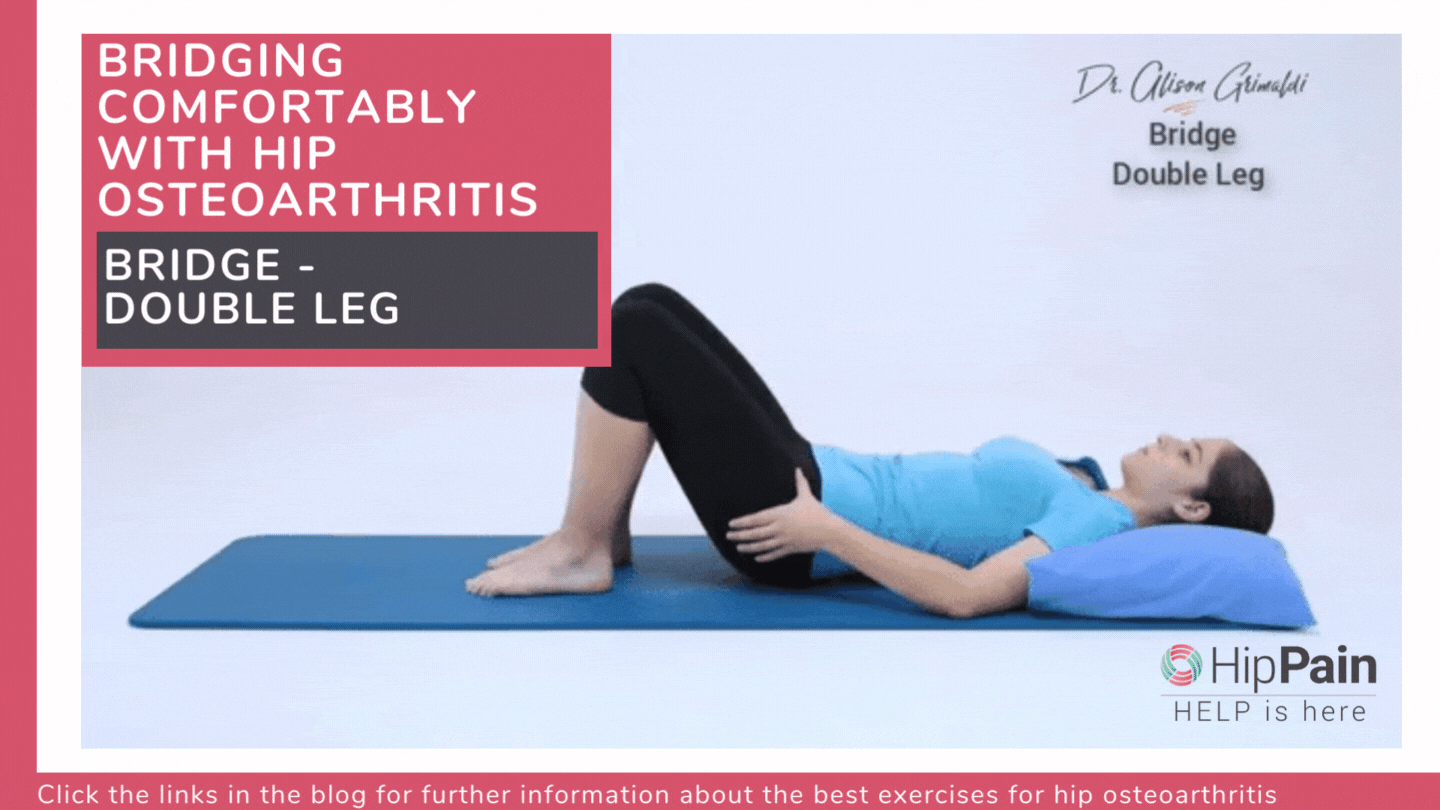
Some people find their hips are aggravated with squatting, but others can’t squat because of back pain. Here are some tips for bridging (sometimes called a pelvic lift) comfortably.
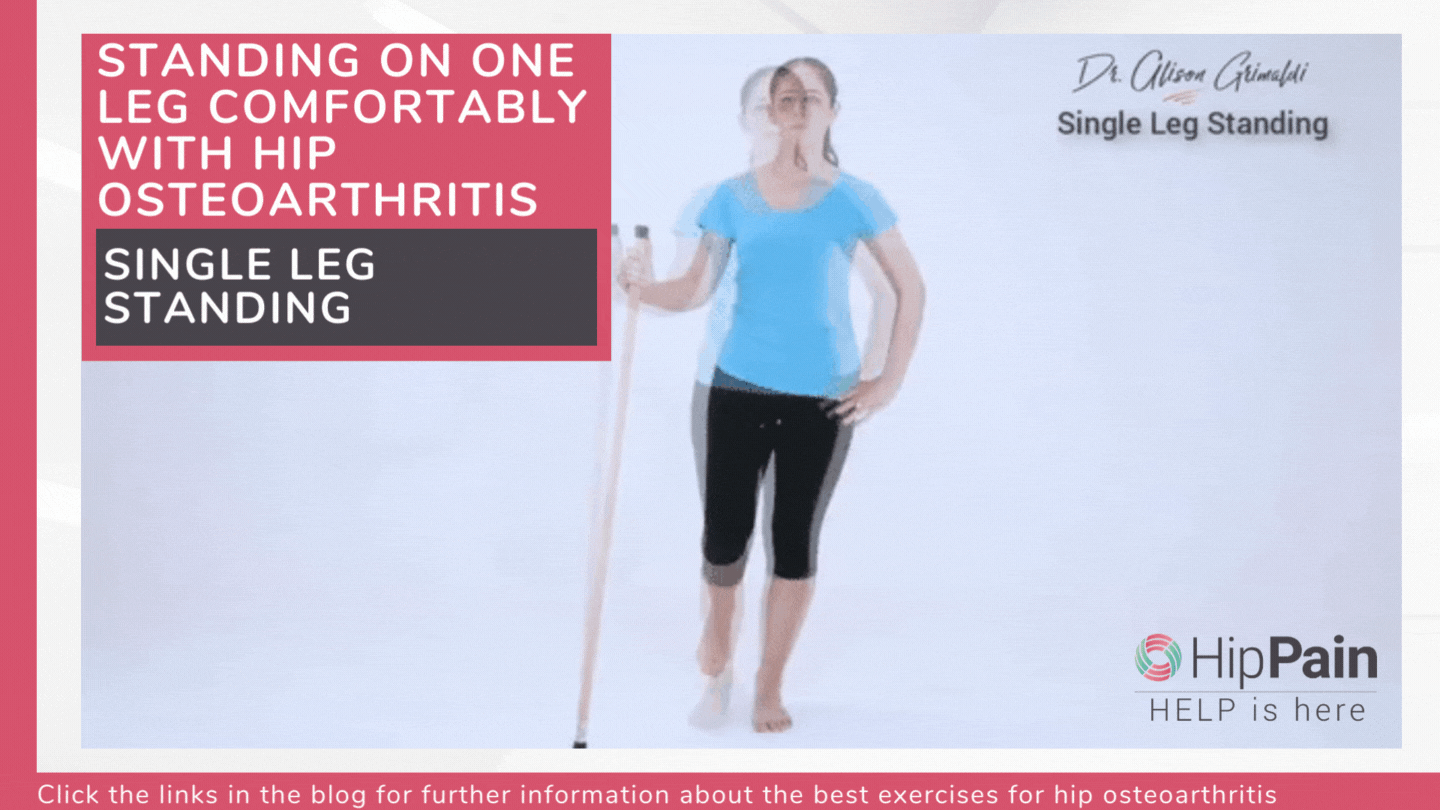
Standing on one leg is a great weightbearing exercise to stimulate the deeper gluteals – the hip abductor muscles, but sometimes this can be very challenging or painful. Here are some tips for practising standing on one leg comfortably.
While most people are aware that strengthening the buttock muscles is important for hip arthritis, the hip flexors regularly get forgotten. They get stretched a lot, which might be actually making things worse (read more on this below) but are not often strengthened. However, these muscles are often weak in people with hip arthritis are this might make it more difficult to lift your leg to dress, walk upstairs, get out of the car or out of bed.
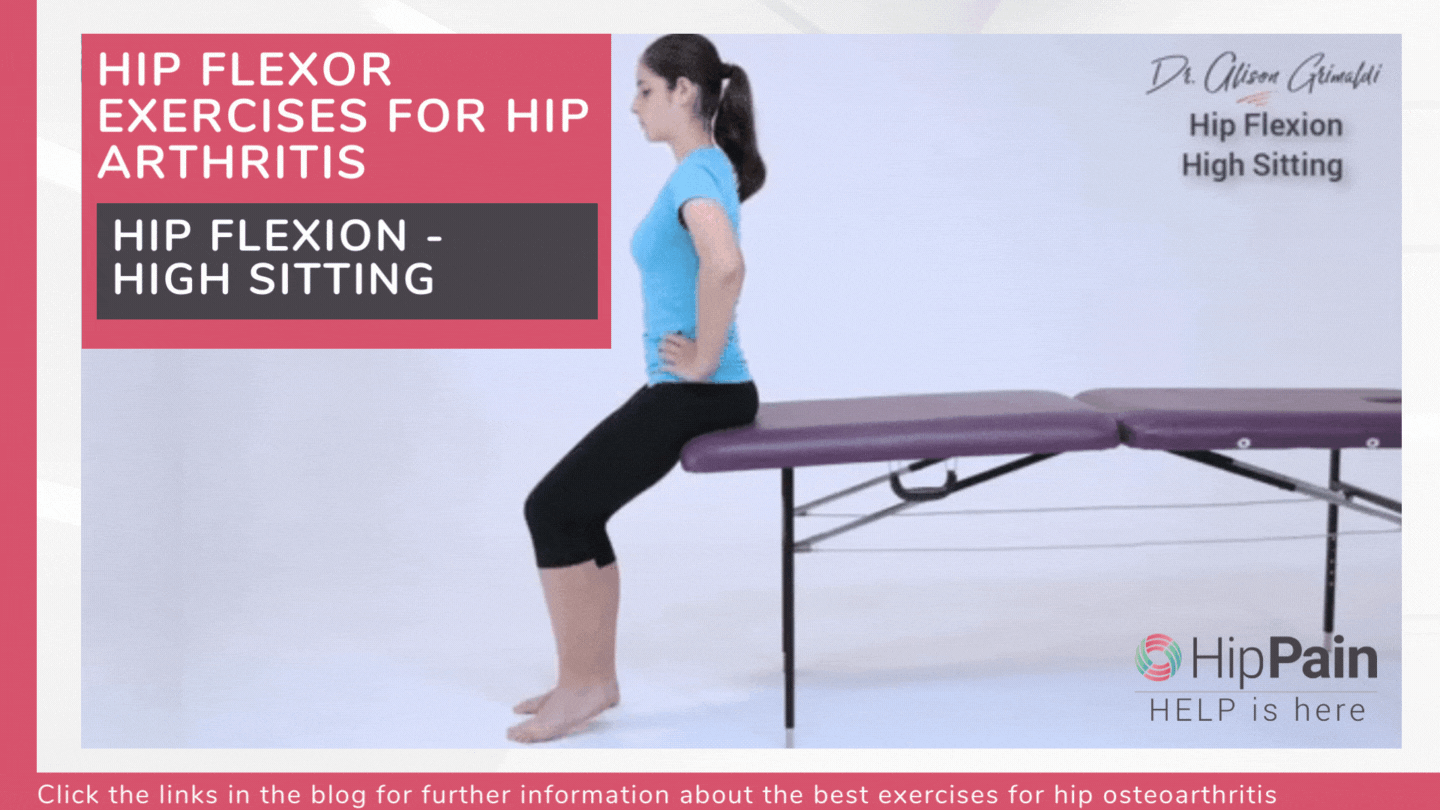
There is scientific evidence to show that exercise in water can help those with osteoarthritis.4 Also, hydrotherapy performed in warm water, can assist with pain and relaxing muscles. If you are finding it difficult to exercise on land, then in a warm pool might be a great place for you to start.
The gym is full of opportunity to perform some of the best exercises for hip osteoarthritis. There are plenty of strengthening exercises you can do, as well as the variety of cardio options we’ve discussed above. You can progress squatting and bridging exercises demonstrated above by adding some weights at the gym. Start light and get some professional instruction before lifting weights at the gym for hip arthritis.
While weights can be fantastic for building strength around the hips, certain exercises can really aggravate hip pain related to arthritis. We have already covered this topic in detail in 2 previous blogs, so we suggest you head to those blogs in you’d like to read more on this topic.
| Which gym exercises should I avoid for hip pain?
|
Ways to reduce hip pain at the gym
|
Apart from pain and weakness, one of the other big issues that stops you doing things when you have hip osteoarthritis is stiffness or lack of mobility.
Loss of range of motion with hip osteoarthritis can be due to a number of factors:
Bony spurs. One of the main restrictions to flexibility in moderate to advanced stages of osteoarthritis, are bony spurs. Extra bone is deposited around the ball and socket joint. This is a part of your body’s attempt to help heal the joint, but unfortunately it can significantly reduce your flexibility. There is nothing that can be done with bony range limitations and forcing the hip into a bony block to joint range will usually just make it very irritated!
Most common range limitations that reduce function in people with hip arthritis include:
Simply lying on your back and forcefully pulling your knee to your chest with your hands is rarely helpful, and often irritating. Try the exercise below for a more gentle and less irritating way to gain flexion range (bend in the hip).
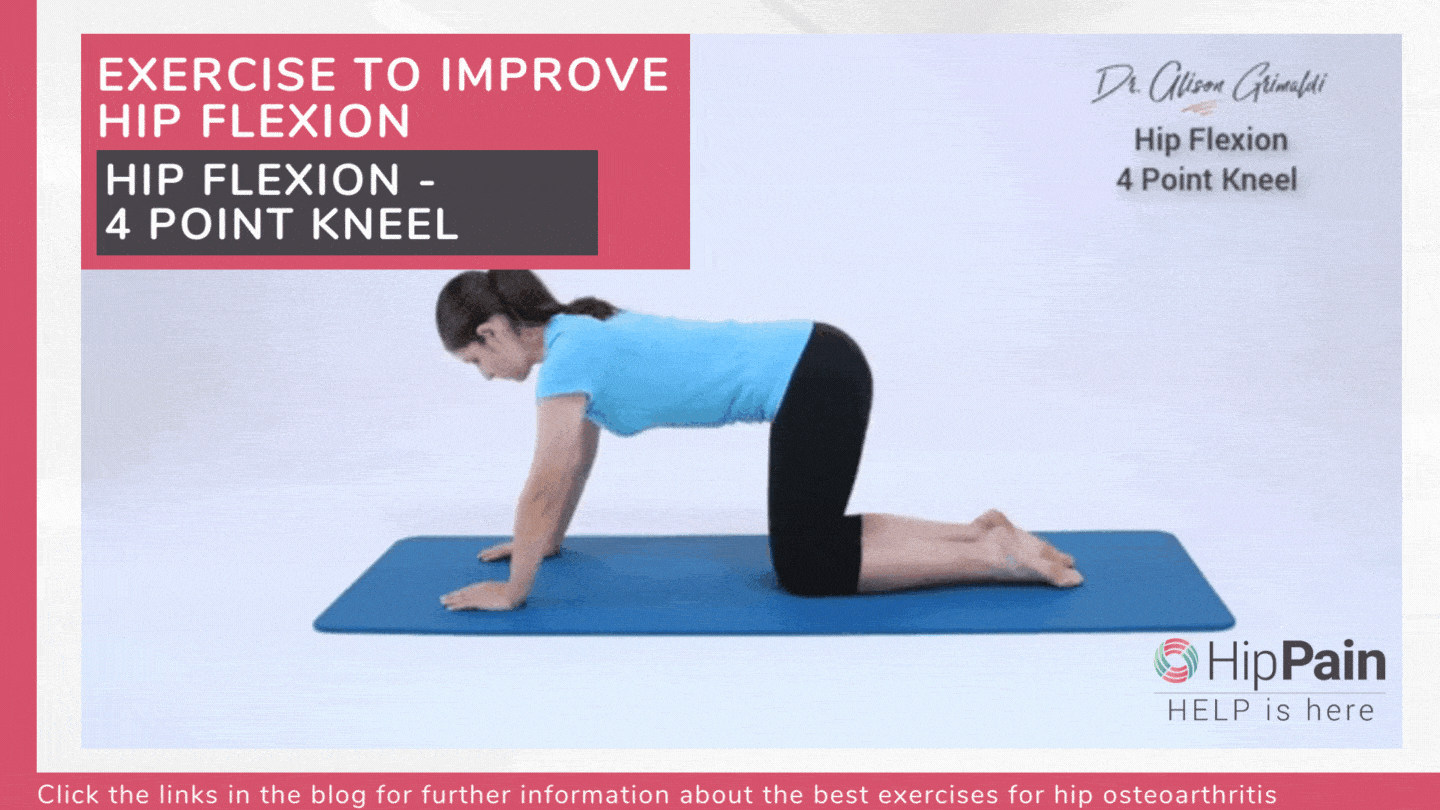
The stiffness with getting your knee out to the side to reach your foot with your hand can be a combination of capsular and muscular tightness and bony restriction. While we can’t change this if it’s bony, there is potential to lengthen the soft tissues (muscles and capsule). Unfortunately, forced stretching into end of range may worse pain associated with hip arthritis. Here is a helpful exercise below for helping relax the inner thigh muscles.
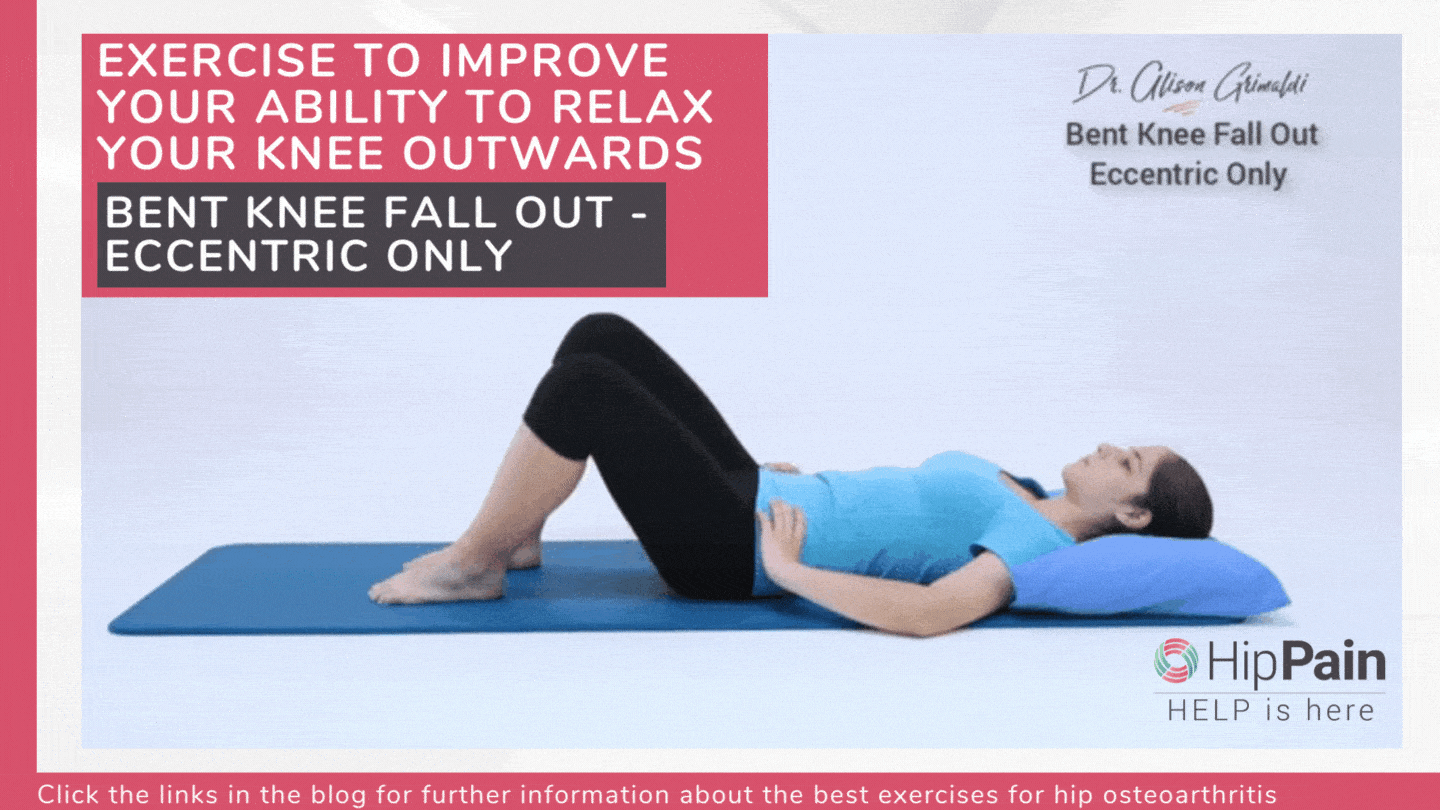
The most common reason for becoming stiff at the front of the hip with hip arthritis is muscle and capsular tightness, and the most common reason for this is simply not using the range. So the simplest way to maintain this range is to use it during everyday postures and movements – within your pain limitation.
If your hip is stuck in a bent position, we recommend you see a health professional to assist you in restoring as much range as possible, as soon as possible. The longer you leave it, the more difficult it is to restore.
Gaining or maintaining as much range as possible with hip osteoarthritis is usually best achieved by ‘active’ range gaining, rather than passive stretching. Active range gaining just means where your muscle is active and controlling the action, as demonstrated in the Bent Knee Fall Out exercise above. Some careful stretching is ok but other types of stretching can increase rather than ease your pain. We have written a whole blog on this topic, so head over there to read more detail.
To read more on stretching and if it can help or irritate your hip further, click here.
Understanding a little about hip osteoarthritis can help you understand some of the key advice in this blog. Hip osteoarthritis is a degenerative joint condition, involving gradual deterioration of the smooth cartilage surfaces of the joint – in the hip, this is the cartilage lining the head of the femur (thigh bone) and the acetabulum (hip socket).
Hip osteoarthritis often develops in response to multiple factors such as:
You can read more background information about hip osteoarthritis, OA, cartilage damage and the ageing hip by clicking here.
Researchers have more recently found a common factor that appears to be linked with the development and worsening of osteoarthritis – inflammation!5 Inflammation can be systemic – in the blood stream, and local – in the joint.
Factors that increase systemic inflammation:
Factors that may increase local joint inflammation due to joint overload:
To control joint inflammation associated with arthritis then, optimise your general health, diet, reduce stress levels, get a good night’s sleep and exercise. Exercise is the key factor that ties most of these things together, as it will improve your general health, alleviate stress, improve sleep and keep your muscles stronger … as long as you are choosing the right exercise or combinations of exercise that help rather than aggravate your hip arthritis.
We hope you have learnt a lot in this extensive blog on best exercises for hip osteoarthritis.
We have covered different types of exercises for hip osteoarthritis – card exercise, strengthening and flexibility exercises, and also how you can modify exercises that are irritating your hip pain. If you have been diagnosed with hip osteoarthritis, we would strongly recommend you see a Hip Pain Professional to help advise you on an individualised management program. They will help you to decide on which exercises are best, how much to do and how often. They will help design a program that fits your needs and goals, time availability and financial situation.
Please also take time to look over the “More to Read” section at the bottom of this blog for loads more information on many of the topics we have raised in this blog.
This blog was written by Dr Alison Grimaldi, physiotherapists, researcher, and educator, who has over 30 years professional clinical experience, dealing with patients suffering from a wide range of hip and pelvic conditions.

Dr. Alison Grimaldi BPhty, MPhty(Sports), PhD, FACP is a fellow of the Australian College of Physiotherapists, Practice Principal of PhysioTec Physiotherapy, an Australian Sports Physiotherapist , an Adjunct Senior Research Fellow at the University of Queensland, as well as an author and global educator

Ways to reduce hip pain at the gym: this blog is packed full of strategies you can use to still go to the gym but modify what you do to reduce any increases in hip pain.
Which gym exercises should I avoid for hip pain? Take an in depth look at some key lower limb gym exercises, which conditions may become irritated by the exercise and why.
Can stretching Make Hip Pain Worse? In this blog we will provide you with a summary of the areas and types of hip pain that may be made worse by stretching. Understand which hip stretches
I have hip pain – What is the best activity for hip pain or is rest best? In this blog we will discuss how much you are doing of something and is that too much or too little!
Hip Osteoarthritis (Hip OA), Cartilage Damage and the Ageing Hip: What is Hip OA, What are the Possible Causes and Symptoms: understand what hip osteoarthritis (OA) means, why it occurs and how you might know if you have it.
Treatment for Hip Osteoarthritis (OA)? Getting Help – What Are The Options? learn about the many options for treatment you have if you think or know you have hip OA
How to Use a Walking Stick & Why: using a support when you walk can be hugely beneficial – learn why. And learn how to set your walking support up correctly for you.
References
